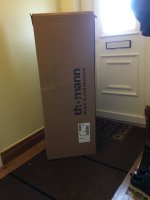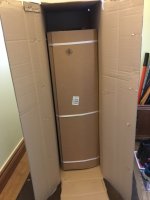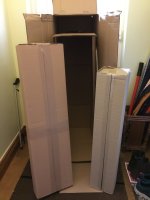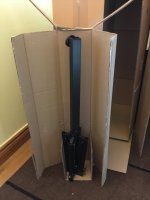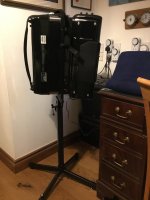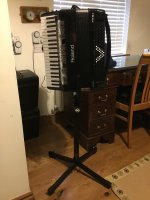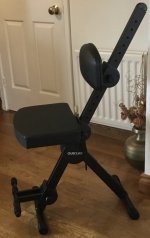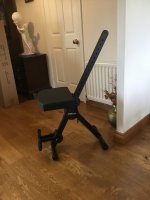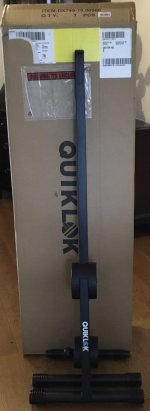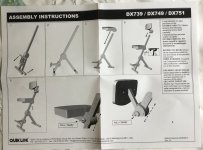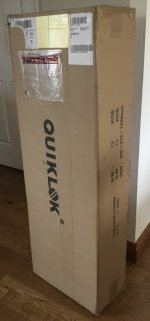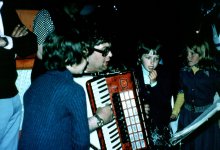Rodney
Active member
Last week I ordered a K&M 174 accordion stand from Thomann’s UK website for £274 incl VAT and delivery from Germany, At the same time I ordered a pair of bellows straps & fittings on the advice of an experienced forum member, they cost £11.25 incl VAT and since they were in the same order, I got free delivery for them too.
My order arrived today in a huge box (Step 1), so I started a solo game of pass the parcel by opening it to, surprise surprise, find another big box inside it (Step 2). The game was getting exciting now, just how much smaller could the next box be? You guessed it, there was another even smaller box inside which on removal revealed a large flat box (Steps 3 & 4) behind it. Surely, soon I must set my eyes on the holy grail accordion stand or, was it all a hoax? What fun!
Taking a deep breath, I opened the shorter box (Step 3) which revealed the substantial 4-legged base for the stand. Next the taller and flatter box (Step 4) which revealed the substantial top of the stand which fits perfectly into the base and is secured using a pin and hole system fixing. This is where I made my first mistake, mostly due to there being no hints about putting it together other than a numbered document in German & English picturing the parts (small document you can spot in the bottom left of Step 6).
As described in a video I’d seen, I knew that the goal was to have the stronger seam around the edge of the bellows fit into the recess of the rubber-like pads, at least I had a guide to what I was doing wrong! IMHO this is not an easy job for one person, I came to this eureka moment after about an hour of failed attempts, the problem being when the pads on one side were in the right position, it was necessary to view another side to line up some other pads/seams and inevitably the first set moved! Laurel & Hardy would have exclaimed about ‘a fine mess…’
I decided to place my accordion on a bed and attach the upper part of the stand to it while my wife helped by keeping an eye on the pads I couldn’t see and let me know if & when they moved, which they did several times. Eventually, tightening knobs a little at a time we managed to get everything positioned. Finally the swivel part for the top was lined up and tightened. The last part was to insert the accordion/upper part into the base so the holes would be on the correct side for the pin to lock it in place. Steps 7 & 8 show the fully assembled stand and accordion.
Sadly this 77 year old was too exhausted for a practice session, other than a few notes to check the height using a dining chair … the stand stops with the base of the accordion about 6 inches above my thighs so I can’t even see the top of my accordion. Fortunately, because my spine complains when I’m on my feet for just a few minutes, my wife bought a bar stool for me which lives in the kitchen, I’ll try it out tomorrow, but rough measurements suggests it’ll be perfect.
In the light of my experiences today, would I do it again? The answer is without a doubt ‘yes’ because putting on my accordion for each practice session was hard on my spine and I was scared of dropping it, also because the strap over my left shoulder caused residual aches in my shoulder.
Just in case my message didn’t get across, the stand is substantial and well engineered. If I were to advise K&M on how to improve the 174 stand, it would be for a member of K&M staff and a current owners who know the product to work together to (1) find the best process to assemble the stand with a 120 bass accordion in, and (2) to make notes during the assembly with a view to producing a user manual that really works for the customer.
In conclusion, I recommend the K&M 174 but it is let down by the lack of assembly instructions, but I hope this review will help bridge the gap and I’m happy to answer queries from interested forum members. In addition, in a week or so I’ll make a post to let people know how I’m getting on with it.
My order arrived today in a huge box (Step 1), so I started a solo game of pass the parcel by opening it to, surprise surprise, find another big box inside it (Step 2). The game was getting exciting now, just how much smaller could the next box be? You guessed it, there was another even smaller box inside which on removal revealed a large flat box (Steps 3 & 4) behind it. Surely, soon I must set my eyes on the holy grail accordion stand or, was it all a hoax? What fun!
Taking a deep breath, I opened the shorter box (Step 3) which revealed the substantial 4-legged base for the stand. Next the taller and flatter box (Step 4) which revealed the substantial top of the stand which fits perfectly into the base and is secured using a pin and hole system fixing. This is where I made my first mistake, mostly due to there being no hints about putting it together other than a numbered document in German & English picturing the parts (small document you can spot in the bottom left of Step 6).
As described in a video I’d seen, I knew that the goal was to have the stronger seam around the edge of the bellows fit into the recess of the rubber-like pads, at least I had a guide to what I was doing wrong! IMHO this is not an easy job for one person, I came to this eureka moment after about an hour of failed attempts, the problem being when the pads on one side were in the right position, it was necessary to view another side to line up some other pads/seams and inevitably the first set moved! Laurel & Hardy would have exclaimed about ‘a fine mess…’
I decided to place my accordion on a bed and attach the upper part of the stand to it while my wife helped by keeping an eye on the pads I couldn’t see and let me know if & when they moved, which they did several times. Eventually, tightening knobs a little at a time we managed to get everything positioned. Finally the swivel part for the top was lined up and tightened. The last part was to insert the accordion/upper part into the base so the holes would be on the correct side for the pin to lock it in place. Steps 7 & 8 show the fully assembled stand and accordion.
Sadly this 77 year old was too exhausted for a practice session, other than a few notes to check the height using a dining chair … the stand stops with the base of the accordion about 6 inches above my thighs so I can’t even see the top of my accordion. Fortunately, because my spine complains when I’m on my feet for just a few minutes, my wife bought a bar stool for me which lives in the kitchen, I’ll try it out tomorrow, but rough measurements suggests it’ll be perfect.
In the light of my experiences today, would I do it again? The answer is without a doubt ‘yes’ because putting on my accordion for each practice session was hard on my spine and I was scared of dropping it, also because the strap over my left shoulder caused residual aches in my shoulder.
Just in case my message didn’t get across, the stand is substantial and well engineered. If I were to advise K&M on how to improve the 174 stand, it would be for a member of K&M staff and a current owners who know the product to work together to (1) find the best process to assemble the stand with a 120 bass accordion in, and (2) to make notes during the assembly with a view to producing a user manual that really works for the customer.
In conclusion, I recommend the K&M 174 but it is let down by the lack of assembly instructions, but I hope this review will help bridge the gap and I’m happy to answer queries from interested forum members. In addition, in a week or so I’ll make a post to let people know how I’m getting on with it.
Attachments
Last edited:

